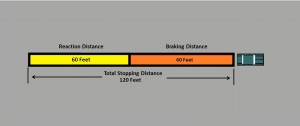Tag Archive: Ask the driving school instructor

Ask The Driving School Instructor: What’s The Best Way To Take A Driving Test?
February 13, 2015
Question: What is the best way to take the written driving test?
Answer: A lot of people have what educators refer to as “test anxiety.” They get so nervous about a test that, even though they may know the material, their anxiety about the test can make even an easy test hard. It doesn’t have to be that way. Here are a few tips to help you be prepared for the test.
Before we go on, we first have to have to understand how the test works and learn a couple of terms. Most state tests are given by computer. The questions come from a large database of up to 1,000 questions and the computer will randomly pick the required number of questions from that database. Because the original database of questions is so large, if you should fail the test and have to take it again, you probably won’t see many of the same questions on your second test.
Each question will consist of the question, only one correct answer, and two or three wrong answers known as “distractors.“
Depending on the state, you may or may not have a time limit in which to take the test. In the case of Florida’s test, you have one hour to answer 50 questions. That means you have two full minutes for each question. That really is a long time and you won’t spend a full two minutes on each question so that gives you more time to answer the harder ones.
So here’s the best way to take the test.
1. Know the material! No matter how smart you may be, if you haven’t studied the material, you stand a good chance of failing the test. For the driving test, the best source of study is the state driver’s handbook. You can get a printed copy from the DMV or download a free copy online from your state’s DMV website. For Floridians, you can download a free copy here: Florida Driver Handbook. You can also take practice tests online that will help you prepare for the test.
2. Read the question carefully! A lot of questions are missed because the test taker didn’t read the question correctly. Take your time and read it carefully so you know exactly what kind of answer the question is looking for.
3. Read all of the answers/distractors carefully. One single word can turn an answer from a correct answer into a distractor.
4. Eliminate the wrong answers. If you aren’t completely sure of the correct answer, you can help yourself by eliminating the wrong answers first. Then you can more easily choose the correct answer.
5. “All of the above” or “none of the above” isn’t always the correct answer; don’t automatically choose those answers without reading all of the other answers first.
6. If there is more than one answer that you absolutely know is true, then “all of the above” is probably the correct answer.
7. If there is one answer that you know for sure is correct, then “none of the above” won’t be the correct answer.
8. If you aren’t sure of the correct answer and you have two answers that appear to be correct, read each one carefully and look for that possible single word that could turn it into a wrong answer. If, after eliminating the ones you know are wrong, you still aren’t sure, then go with your best guess.
9. Your first choice is probably the best choice. Don’t try to second guess yourself and go back and change an answer. The only time you should go back and try to change an answer is if a later question makes you realize that you were wrong on the previous question. Still, don’t change it unless you are absolutely positive that you were wrong the first time. If you aren’t sure, leave it alone. Remember that you’re using up time to go back and change an answer.
Good luck!

Ask The Driving School Instructor: Braking Distance VS Stopping Distance
December 3, 2014
Question: I’m studying for my driving exam and I’m confused about the difference between stopping distance and braking distance.
Answer: It can be a little confusing, I’ll try to sort it out for you.
If you encounter an emergency on the road requiring you to stop suddenly, there are two parts that make up the total stopping distance.
- Reaction distance
- Braking distance
When you’re in an emergency situation, it takes time to react to the emergency, to brake, and to finally bring your vehicle to a complete stop. Remember that your vehicle is traveling a surprisingly long distance every second. At 40 mph, your vehicle will travel approximately 60 feet per second and a lot can happen in that short amount of time.
Reaction time
The time it takes you to react and respond to an emergency can be broken down into three parts:
- Perception or awareness time
- Decision time
- Action time
Let’s look at each part by imagining a scenario that requires you to make a sudden stop. Let’s say that you are traveling at 40 mph when the driver of the car ahead of you suddenly applies his brakes.
Perception time
The perception or awareness time is how long it takes before you are even aware that the driver ahead is suddenly stopping. If you aren’t expecting an emergency, it will take time before you realize that the car ahead is suddenly braking
Decision time
Now that you’re aware of the emergency ahead, you have to decide what to do. Will you hit the brakes or swerve into another lane to go around? If you try to change lanes, is the lane clear or are there other vehicles that may be in the way? It takes time to decide what to do. In our emergency, let’s say that you decide to hit the brakes but that decision took time
Action time
Now that you’ve decided you’re going to brake, you have to move your foot from the gas pedal to the brake pedal and push it all the way down. That also ate up precious time.
For the average person, the total reaction time can take from three-quarters to a full second. At 40 mph, if your reaction time is one full second, you’ll have traveled almost 60 feet before applying the brakes.
Braking Distance
Now that you’ve applied the brakes, it still takes time to come to a complete stop. For an average car that weighs almost 3,000 pounds, that can take up to 60 feet.
Total stopping distance
So, the total stopping distance is made up of both the reaction distance plus the braking distance. Adding the two together means that, at 40 mph, it can take up to 120 feet before your vehicle will come to a complete stop. That’s why maintaining a safe following distance between you and the vehicle ahead is so important.
To test your reaction time, visit: How fast is your reaction time?

Ask The Driving School Instructor: Driving With One Hand
August 25, 2014
Question: Is it safe to drive with one hand?
Answer: I will say that it’s only safe to drive temporarily with one hand but not all the time. If you need to adjust a control such as the air conditioner or windshield wipers or to pick up something one hand on the wheel is fine. However, you shouldn’t get in the habit of driving with one hand all the time. Driving with one hand doesn’t give you full control over steering and it could hurt you very badly in certain circumstances. Let’s look at a couple of the ways that driving with one hand could be dangerous.
Driving distractions can be even more dangerous when driving with one hand. Most people tend to put their hand at the top of the steering wheel. If you were to to turn your body to look for or to reach for something, you may inadvertently pull the wheel in the direction your body is turning. If that happens while your eyes are off the road, you could drive over into the other lane or off the side of the road.
If you were suddenly involved in a traffic crash in which your airbag deployed, with one hand positioned at the top of the wheel, your hand and arm are going to be driven back into your face at 200 mph. It could break your arm and it isn’t going to do wonders for your face either.
Older drivers were taught to always keep their hands at the 9 or 10 o’clock and 3 or 2 o’clock positions on the steering wheel. Today, because of airbags, safety experts suggest keeping your hands lower on the wheel at the 8 and 4 o’clock positions. Don’t wrap your thumbs around the wheel. Instead, rest your thumbs on top of the wheel. With your hands and thumbs in this position, you’ll have more control and you’re less likely to be injured if your airbag deploys.

Ask The Driving School Instructor: Most Dangerous Type Of Road
June 3, 2014
Question: What is the most dangerous type of road to drive on?
Answer: Most people assume, because of the high speeds involved, that interstates or freeways are the most dangerous type of road but they aren’t. The most dangerous type of roads for all drivers but especially for teens are two-lane country or rural roads. Fifty-seven percent of teens killed in traffic crashes die on rural roads.
The reason that rural roads are so dangerous is that they are usually narrow and tend to curve and wind and can also be hilly. These types of roads leave very little room for escape in an emergency. At night they can be especially dangerous because it is hard to see curves or other hazards ahead.
Often drivers drive too fast on these roads and, even though there are usually signs pointing out a curve ahead, they enter the curve at too high a speed and can’t keep the car on the road. If a driver is distracted and drives off the side of the road, there is usually little or no room to recover. Drivers also can become frustrated when stuck behind slower vehicles ahead and that may lead them to take stupid chances such as passing in a no-passing zone where they can’t see the road ahead.

